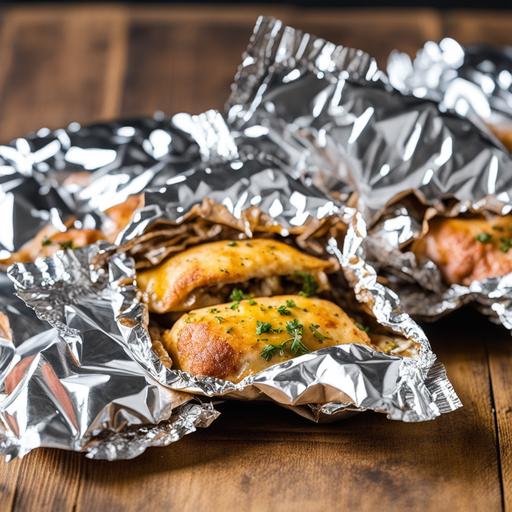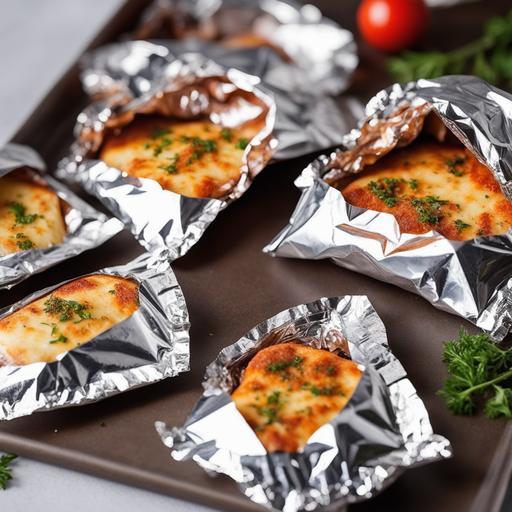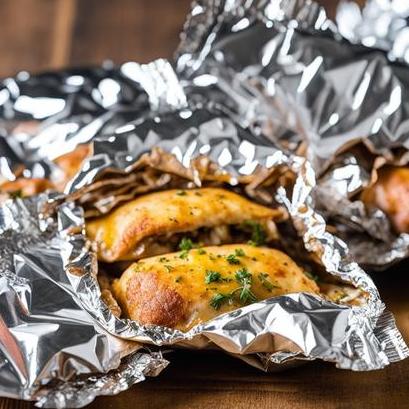
Foil Packets Oven Recipe: A Delightful And Hassle-Free Cooking Method
Cooking delicious, flavorful meals doesn’t have to be a daunting task. With the foil packets oven recipe, you can easily prepare a delightful feast with minimal effort and maximum flavor. This comprehensive guide will walk you through the ins and outs of this cooking technique, including food science, culinary details, selection, cleaning, preparation, tips, variations, doneness checks, and troubleshooting. So, let’s dive into the world of foil packets and explore a fantastic way to elevate your culinary skills!
Understanding the Science behind Foil Packets
The art of cooking in foil packets is based on the principle of steaming. By enveloping your ingredients in a sealed pouch, the food is gently cooked using the steam generated inside. This process ensures that the flavors mingle and intensify, resulting in tender and moist dishes. The foil acts as an efficient conductor of heat, distributing it evenly throughout the packet, guaranteeing consistent cooking.
Culinary Details and Ingredient Selection
When it comes to foil packets, the possibilities are endless. You can create a variety of dishes using different combinations of proteins, vegetables, herbs, and spices. The key is to select ingredients that have similar cooking times. This ensures that everything in the packet is perfectly cooked when you open it.
Proteins like chicken, fish fillets, shrimp, or even tofu work wonderfully in foil packets. Pair them with an array of colorful vegetables such as bell peppers, zucchini, carrots, or asparagus for a complete and nutritious meal. Fresh herbs like basil, thyme, rosemary, or cilantro add a burst of aromatic flavors to your creation.
Cleaning and Preparing Foil Packets

Before diving into the cooking process, it’s essential to ensure that you’re using clean and high-quality aluminum foil. Choose heavy-duty foil to avoid any tearing or leakage during cooking. Always hand wash your foil packets, gently scrubbing away any remnants of the previous use. This prevents cross-contamination and ensures the flavors of the current dish stay uncompromised.
Once your foil sheets are clean, it’s time to prepare the packets. Tear off a sheet of foil approximately twice the size of your chosen ingredients. Place the ingredients in the center, leaving ample room for folding and sealing. Fold the foil in half, bringing the edges together. Beginning from one of the open sides, fold over the edges tightly, creating a seal that encloses the contents securely.
Tips for Perfect Foil Packets

To ensure your foil packets turn out perfect every time, here are some valuable tips:
-
Oil or Non-Stick Spray: Before placing your ingredients in the foil, lightly coat the inner surface with oil or non-stick spray. This prevents sticking and makes the cleaning process easier.
-
Even Ingredient Distribution: Arrange your ingredients in a single layer to ensure even cooking and prevent any over or undercooked portions.
-
Proper Seasoning: Season your ingredients generously with salt, pepper, and any other spices or herbs according to your taste preferences. Don’t be afraid to experiment with different flavor profiles!
-
Sealing Technique: Fold and seal your foil packets tightly to prevent any steam from escaping. This ensures proper steaming and intensifies the flavors.
Alluring Variations to Explore

The beauty of foil packets lies in their versatility. You can create a wide range of delicious meals by experimenting with different ingredients and flavors. Here are a few variations to inspire your culinary adventures:
1. Mediterranean Delight:
-
Protein: Salmon fillets
-
Vegetables: Cherry tomatoes, artichoke hearts, Kalamata olives
-
Seasonings: Oregano, lemon zest, garlic
-
Serve with couscous and a side of tzatziki sauce.
2. Asian Fusion:
-
Protein: Shrimp
-
Vegetables: Snap peas, bell peppers, mushrooms
-
Sauce: Soy sauce, ginger, minced garlic
-
Serve over steamed rice garnished with sesame seeds and green onions.
3. Tex-Mex Feast:
-
Protein: Chicken breasts
-
Vegetables: Corn kernels, black beans, diced tomatoes, jalapeños
-
Seasonings: Cumin, paprika, chili powder
-
Serve with warm tortillas, sour cream, and guacamole.
Feel free to customize these recipes to suit your preferences and dietary needs. The foil packets method allows for endless creativity and taste exploration!
Checking for Doneness and Avoiding Under or Overcooking

Determining the doneness of your foil packets is crucial to ensure you achieve perfectly cooked and safe-to-eat meals. Here are a few ways to check if your meal is ready:
-
Temperature:
-
Proteins: Use a meat thermometer to check if your proteins have reached the desired internal temperature. For example, chicken should reach 165°F (74°C), while fish should be 145°F (63°C).
-
Vegetables: Test the tenderness of your vegetables by inserting a fork or toothpick. If they offer little resistance, they are ready!
-
-
Appearance: Carefully unwrap a small corner of the foil packet, ensuring you don’t burn yourself. Examine the visual cues of doneness. Proteins should appear opaque, while vegetables should be tender and vibrant.
-
Experience and Experimentation: With practice, you’ll begin to develop an intuition for the cooking times of different ingredients. Keep a log of your cooking experiences to refine your favorite recipes.
Must-Try Foil Packets Oven Recipe
Now that you’re well-versed in the art of foil packets, let’s explore a delectable recipe to showcase your newfound skills:
Lemon Herb Salmon with Roasted Vegetables
Ingredients:
-
2 salmon fillets
-
1 zucchini, sliced
-
1 red bell pepper, cut into strips
-
1 yellow bell pepper, cut into strips
-
1 tablespoon olive oil
-
2 tablespoons fresh lemon juice
-
2 cloves garlic, minced
-
1 teaspoon dried dill
-
Salt and pepper to taste
Instructions:
-
Preheat the oven to 400°F (200°C).
-
Tear off two sheets of heavy-duty aluminum foil, each approximately twice the size of the salmon fillets.
-
Place one salmon fillet in the center of each foil sheet.
-
In a bowl, combine the sliced zucchini, bell pepper strips, olive oil, lemon juice, minced garlic, dried dill, salt, and pepper. Toss until well-coated.
-
Divide the vegetable mixture equally and lay it on top of each salmon fillet.
-
Fold the foil in half, bringing the edges together, and tightly seal the packets.
-
Place the sealed packets on a baking sheet and bake in the preheated oven for 15-20 minutes.
-
Once cooked, carefully remove the packets from the oven and let them rest for a minute or two before opening.
-
Serve the succulent lemon herb salmon and roasted vegetables directly from the foil packets for added convenience and presentation.
Troubleshooting Foil Packets
Sometimes, even the most seasoned cooks encounter challenges. Here are a few troubleshooting tips to overcome common issues with foil packets:
-
Leakage: If you notice any leaks while cooking, reinforce the seals by folding the edges again or transferring the contents into a new foil packet.
-
Uneven Cooking: To combat uneven cooking, ensure ingredients are sliced or diced to similar sizes. Thinner cuts will cook faster, so adjust accordingly.
-
Flavor Intensity: If you find your dish is lacking flavor intensity, experiment with additional seasonings or marinating your proteins before assembling the foil packets.
With time and practice, you’ll become a master of foil packets, expertly avoiding any potential pitfalls!
Conclusion
Congratulations! You’re now equipped with the knowledge and skills to embark on a foil packet journey. Whether you’re a novice home cook or an experienced chef, this versatile cooking technique offers convenience, flavor, and endless possibilities. Remember to experiment, try new combinations, and trust your instincts. Let the foil packets oven recipe be your gateway to a world of culinary exploration!
Happy cooking!
Sources
FAQS On Foil Packets Oven Recipe
What Are Foil Packet Oven Recipes?
Foil packet oven recipes involve cooking ingredients in a sealed foil packet. This method is often used for cooking meals in the oven as it helps to lock in moisture and flavor, and it also makes for easy cleanup.
What Types Of Dishes Can Be Made Using Foil Packet Oven Recipes?
Foil packet oven recipes can be used to cook a wide variety of dishes, including chicken, fish, vegetables, and even desserts. The method works well for meals that can benefit from steaming or being cooked in their own juices.
How Do I Make A Foil Packet For The Oven?
To make a foil packet for the oven, simply place the ingredients in the center of a large piece of aluminum foil. Fold the sides of the foil over the ingredients and then fold the top and bottom edges to seal the packet. Be sure to leave a little room for expansion and steam to circulate inside the packet.
Can I Use Any Type Of Foil For Foil Packet Oven Recipes?
It is recommended to use heavy-duty aluminum foil for foil packet oven recipes, as it is more durable and less likely to tear or puncture during cooking. Regular aluminum foil can be used, but it may require double-layering to prevent leaks.
What Temperature And Cooking Time Should I Use For Foil Packet Oven Recipes?
The temperature and cooking time for foil packet oven recipes will vary depending on the specific dish being prepared. As a general rule, a moderate temperature of 375°F to 400°F (190°C to 205°C) is often used, and the cooking time can range from 20 to 40 minutes, depending on the ingredients and their preparation. It’s important to ensure that all ingredients are fully cooked before serving.


